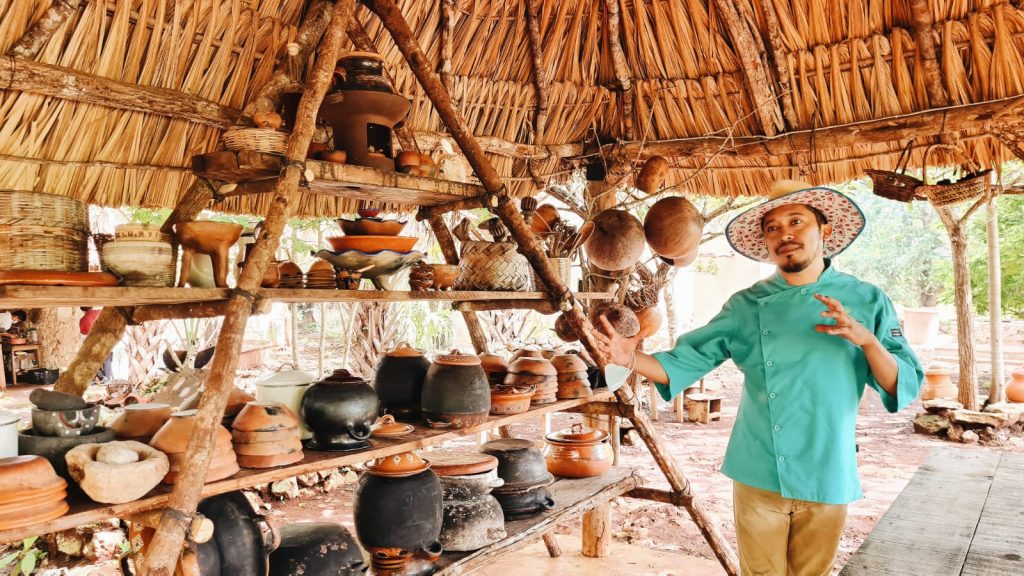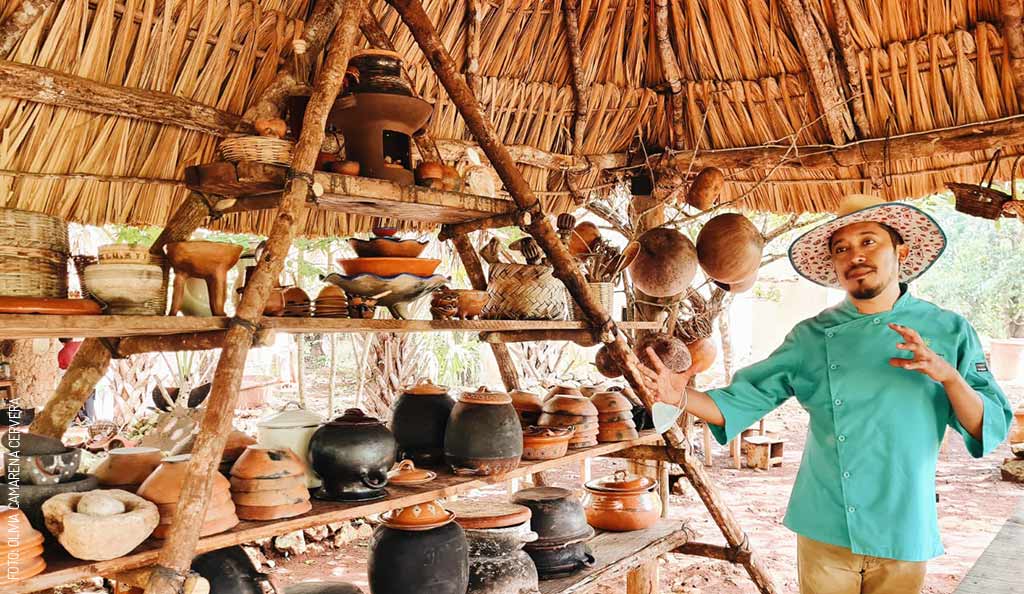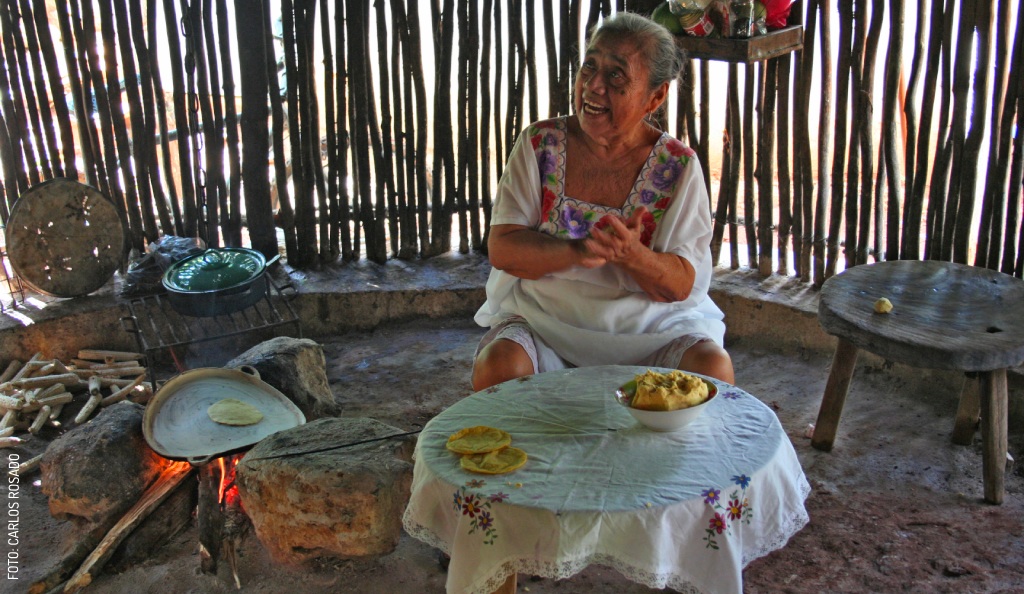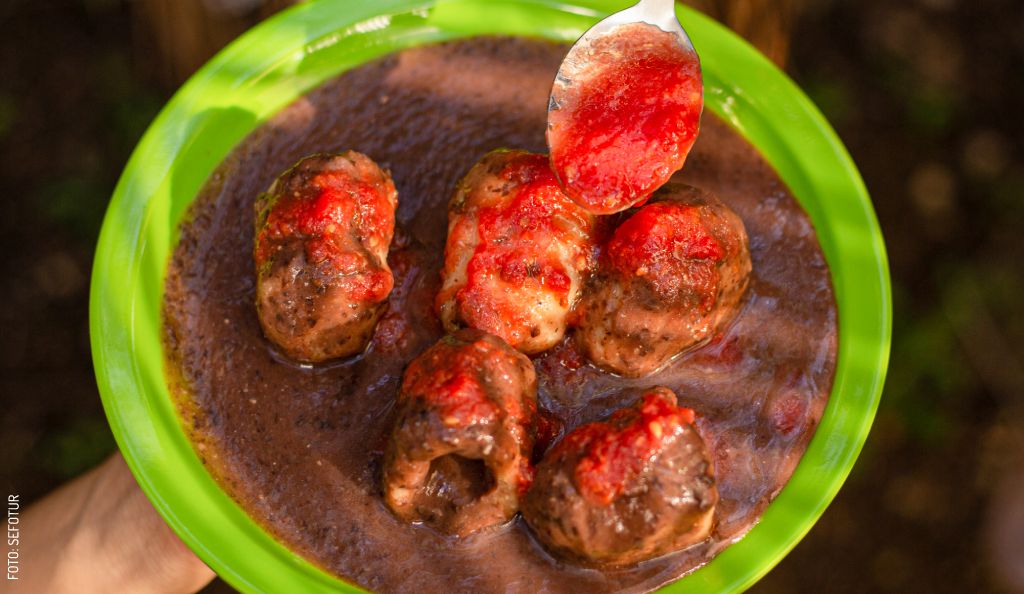
Ya'axche: a Foodie Adventure
Ya’axche, the sacred tree of the Maya, the center of the universe: an essential element at the heart of chef Wilson Alonzo’s ethno-gastronomic project, far beyond just the name. A young ceiba greets you at the entrance, seemingly as a marker that you’re entering a new world, and you very well may be. In Ya’axche you lose yourself in the quiet, the Maya spirituality, and the dynamics and aromas that go with a kitchen.
Ya’axche is located in the small town of Halachó, very close to the neighboring state of Campeche. This ethno-gastronomic center offers multiple approaches to the most traditional of Yucatecan cuisine, techniques and ingredients passed down for generations. All of this, surrounded by a wonderful natural environment, laid out by a Maya field that has been in Wilson’s family for decades, and which also includes palapas, open-air kitchens, and, beyond the outdoor kitchen, a Milpa (planting field) worked by Mr. Alonzo with a couple of ceibas; one of them, “ceremonialized.”
A ceremonialized ceiba is far from being a normal ceiba, which you pass by on a daily basis. It is sacred, as there is to be a ritual when it is planted, and then another one to ask it to protect the area. After those, offerings of copal, honey, sakab, brandy, and incense are made regularly. Located in the center of the Milpa, the ceremonialized ceiba at Ya’axche was consecrated on January 3, 2018. Chef Wilson made very clear to us the great value of these ceibas, in addition to conveying to us this need to respect such an important piece of Maya spirituality. Admire it from afar and, if you have the opportunity, ask them to tell you a little about its history.
Back to the kitchen. Your role in this adventure will really depend on how involved you want to get with the preparation of the food. If you're not afraid of getting your hands dirty, using knives, grilling at the stations of an outdoor kitchen surrounded by foliage, and following a long list of steps to transform simple ingredients into delicious dishes, the classes (whether a demo class or a master class) are a great option. If you are afraid of any or all of the activities mentioned above, you may be surprised to hear the classes may also be right for you. I am lousy in the kitchen, my skills are non-existent; not only did I get out alive, but I cooked a Cochinita Pibil (Recado made from scratch and all) to die for.
First, shopping in the market
This adventure begins in the Halachó market, very early in the morning (you have to buy the ingredients for breakfast, after all). Your guide, in our case, Chef Wilson, will take you through all the aisles in search of supplies for the day. You can be sure that Wilson will introduce you to his aunts (sellers in the market), greet the merchants, and stop by to buy some flowers. Keep a curious eye out. Here you can catch the small details of everyday life: a girl asking for some tomatoes; her mother a few stalls further, with the butcher; a puppy guarding a lady's stall; a vendor waiting for his merchandise’s arrival.
Wilson will prompt you to select the vegetables. Take this opportunity to have Wilson explain how to choose tomatoes, limes, and others. There will be ingredients that they will not buy at that moment, but you can be sure that they are from somewhere nearby; everything is bought from local producers.
Let’s get to work
Once in Ya’axche, and after entering a path that becomes muddy in the rainy season, we first have breakfast in the company of the chef. We were served scrambled eggs with mint—so good they might have been from another planet; juicy fruit, and fresh seasonal fruit-based drinks. We also tried different kinds of tamales that we bought in the market. As nice as this peaceful little moment is, accompanied by tasty food and surrounded by nature, you shouldn’t get too comfortable: After breakfast, it's time for a general explanation of how each dish will be made, and you’ll get down to work.
I was so relaxed I was almost sleepy, so catching the instructions was a challenge. Thank heavens I wasn’t alone. Well, you never will; either the chef or his team of young cooks is there right beside you, guiding you and answering your questions. If you’re from around here, you may already have some idea of how the dishes are made, because everyone will make a Yucatecan dish. As I mentioned, I made the Cochinita Pibil (I confess I didn't know what I was getting myself into). My fellow adventurers made other Yucatecan delicacies: Sopa de Lima (a gem), Sikil P'aak, Escabeche Oriental, But Negro, and Tóoksel-stuffed Polcanes.
Of the dishes we chose, Cochinita Pibil was the most labor-intensive: you make the Recado from scratch (an art), then you prepare the pork and help Wilson place it in the Pib (underground oven) for two hours. When the Cochinita is ready and unearthed, you’ll be able to enjoy all your dishes in the peaceful palapa. The restaurant-like plating and the extraordinary flavor may make you question whether you really made that dish, but yes, your effort will have paid off, thank you. After a several-course meal (I hope you are hungry), you will proceed to taste the only thing you didn’t help cook: the house dessert. I won’t spoil it, but you will be surprised by how lovingly it is made.
How long does the master class take? For reference, we arrived for breakfast—we must have sat down at around 9 am—and dessert was served around 6 pm. It should be noted that we spent some time talking with the chef, exploring Halachó, and doing a ceiba ceremony in the Milpa.
Demo Class:
- 2 to 10 people: $900 pesos per person
- 11 to 20 people: $750 pesos per person
Piíbil, Burial Workshop (Taller de Enterrado):
- 2 to 20 people: $1,600 pesos per person
Master Class:
- 2 to 12 people: $2,500 pesos per person
Ya'axche's restaurant
I understand that cooking is not everyone’s cup of tea. However, that is not an obstacle to try chef Wilson Alonzo’s outstanding recipes. Ya’axche opens its doors as a restaurant from Friday to Sunday from 11:30 am to 5:30 pm.
As in the master class and the demo class, the ingredients are from the area and traditional techniques are followed to prepare each dish.
At the end of the visit, whichever option you’ve chosen, I can assure you that you will leave fascinated by the very Yucatecan experience, so local, with abundant flavor and aroma. If you add to this the outdoor space, surrounded by tall trees, and the chef's charisma...it's a visit you'll want to repeat more than once.
Cel. 997 128 6409
Email: yaaxcheinstitute@gmail.com
IG: Yaaxche
FB: Yaaxche
First published in Yucatán Today print and digital magazine no. 419, in November 2022.
Last update November 2025.

Author: Olivia Camarena Cervera
Yucatecan communicologist. Writer, blogger, and bookstagrammer in her spare time. She also experiments with TikTok.
¿Enamorado de Yucatán? Recibe en tu correo lo mejor de Yucatán Today.
No te pierdas nuestros mejores artículos y la edición digital cada mes antes que nadie.
Related articles

Culinary Experiences: Three Traditional Kitchens
If learning how the exquisite and authentic Yucatecan flavors are created sounds appetizing to you, stick around for 3 Traditional Kitchens.
True to the Essence: The Maya Kitchen and Its Cultural Significance
Explore the Maya kitchen, and discover the fusion of ancient flavors, traditions, and the challenges in preserving this so important cultural legacy.



